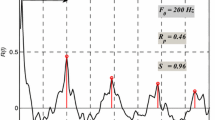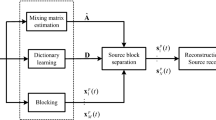Abstract
A limitation in many source separation tasks is that the number of source signals has to be known in advance. Further, in order to achieve good performance, the number of sources cannot exceed the number of sensors. In many real-world applications these limitations are too restrictive. We propose a method for underdetermined blind source separation of convolutive mixtures. The proposed framework is applicable for separation of instantaneous as well as convolutive speech mixtures. It is possible to iteratively extract each speech signal from the mixture by combining blind source separation techniques with binary time-frequency masking. In the proposed method, the number of source signals is not assumed to be known in advance and the number of sources is not limited to the number of microphones. Our approach needs only two microphones and the separated sounds are maintained as stereo signals.
Preview
Unable to display preview. Download preview PDF.
Similar content being viewed by others
References
Hyvärinen, A., Karhunen, J., Oja, E.: Independent Component Analysis. Wiley, Chichester (2001)
Roman, N., Wang, D.L., Brown, G.J.: Speech segregation based on sound localization. J. Acoust. Soc. Amer. 114, 2236–2252 (2003)
Yilmaz, O., Rickard, S.: Blind separation of speech mixtures via time-frequency masking. IEEE Trans. Signal Processing 52, 1830–1847 (2004)
Wang, D.L., Brown, G.J.: Separation of speech from interfering sounds based on oscillatory correlation. IEEE Trans. Neural Networks 10, 684–697 (1999)
Bregman, A.S.: Auditory Scene Analysis, 2nd edn. MIT Press, Cambridge (1990)
Jourjine, A., Rickard, S., Yilmaz, O.: Blind separation of disjoint orthogonal signals: Demixing N sources from 2 mixtures. In: Proc. ICASSP, pp. 2985–2988 (2000)
Roweis, S.: One microphone source separation. In: NIPS 2000, pp. 793–799 (2000)
Hu, G., Wang, D.L.: Monaural speech segregation based on pitch tracking and amplitude modulation. IEEE Trans. Neural Networks 15, 1135–1150 (2004)
Wang, D.L.: On ideal binary mask as the computational goal of auditory scene analysis. In: Divenyi, P. (ed.) Speech Separation by Humans and Machines, pp. 181–197. Kluwer, Norwell (2005)
Araki, S., Makino, S., Sawada, H., Mukai, R.: Underdetermined blind separation of convolutive mixtures of speech with directivity pattern based mask and ICA. In: Puntonet, C.G., Prieto, A.G. (eds.) ICA 2004. LNCS, vol. 3195, pp. 898–905. Springer, Heidelberg (2004)
Kolossa, D., Orglmeister, R.: Nonlinear postprocessing for blind speech separation. In: Puntonet, C.G., Prieto, A.G. (eds.) ICA 2004. LNCS, vol. 3195, pp. 832–839. Springer, Heidelberg (2004)
Pedersen, M.S., Wang, D.L., Larsen, J., Kjems, U.: Overcomplete blind source separation by combining ICA and binary time-frequency masking. In: Proceedings of the MLSP workshop, Mystic, CT, USA (2005)
Parra, L., Spence, C.: Convolutive blind separation of non-stationary sources. IEEE Trans. Speech and Audio Processing 8, 320–327 (2000)
Büchler, M.C.: Algorithms for Sound Classification in Hearing Instruments. PhD thesis, Swiss Federal Institute of Technology, Zurich (2002)
Allen, J.B., Berkley, D.A.: Image method for efficiently simulating small-room acoustics. J. Acoust. Soc. Amer. 65, 943–950 (1979)
Author information
Authors and Affiliations
Editor information
Editors and Affiliations
Rights and permissions
Copyright information
© 2006 Springer-Verlag Berlin Heidelberg
About this paper
Cite this paper
Pedersen, M.S., Wang, D., Larsen, J., Kjems, U. (2006). Separating Underdetermined Convolutive Speech Mixtures. In: Rosca, J., Erdogmus, D., Príncipe, J.C., Haykin, S. (eds) Independent Component Analysis and Blind Signal Separation. ICA 2006. Lecture Notes in Computer Science, vol 3889. Springer, Berlin, Heidelberg. https://doi.org/10.1007/11679363_84
Download citation
DOI: https://doi.org/10.1007/11679363_84
Publisher Name: Springer, Berlin, Heidelberg
Print ISBN: 978-3-540-32630-4
Online ISBN: 978-3-540-32631-1
eBook Packages: Computer ScienceComputer Science (R0)




